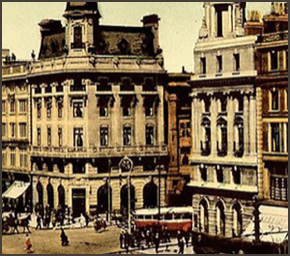

The Grand Central Café Bar (est 1824) extends you a warm welcome. Why not drop in, whether it’s for a pint and a chat with the friendly staff, or booking in your work colleagues for a fun night of music and dancing in the downstairs bar you’ll be sure to have an excellent evening.If you are taking the Luas red line, you will see us at the O’Connell Street Stop, so if you heading to the 3 Arena make sure you drop in for a pre-concert or post-concert drink or bite to eat.
Savour some of the amazing cocktails from our extensive menu or have a bite to eat with friends, with mouth-watering dishes, prepared in front of you in our open plan kitchen by our experienced chefs. If you want to watch the match we show all major Live sporting events on our Tvs. If you are looking to Book your Party with us, We have a function/club room available downstairs and we can cater for all your party needs
This premises, which only became a licensed hostelry in 2003, is steeped in historical tradition. Though the two premises no’s. 10 & 11 did not become one until the Munster & Leinster Bank acquired no. 11 from Joseph Dunn in November 1926, both properties were intrinsically linked since the early 1800’s. In the early years of the 19th century, Owen Gallagher plied his trade here as a much sought-after tailor until landlord, Benjamin Ball Esq., decided to completely rebuild no. 11 Sackville Street ( now O’Connell St.) in 1824. The new creation, which is referred to in the title deeds ‘as the new Brick Dwelling House and Premises together with the yard at rear’ was now leased to Francis Westley, Merchant of the City of London, for a yearly rent of 113-15-0 pounds and a goodwill payment stg 1137 on November 17th 1825.

By the 1880s Francis William Morgan was the beneficial owner of these leased properties. In 1892 he publicly auctioned no.10 for the princely sum of 600 pounds. He sold out his remaining interest in no. 11 to Richard Hawkins Beauchamp in 1899 at which time Joesph Byron McKenna carried on a thriving Tobacconist’s trade at these leased properties.
Alderman William McCarthy was the beneficial owner of no.10 during Easter Week 1916 when the premises was extensively damaged in the Rising. The damage was caused primarily by a shell from HMS Helga which had sailed up the Liffey and commenced shelling the GPO; many of the shells fell short causing extensive property damage and loss of life in both Abbey St. and Sackville St. A detailed cost of repair estimate (which has remarkably been preserved over the years) totalling 2515-5-7 pounds – in excess of 250,000 euro in today’s money – was presented to the authorities in August 1916 and promptly settled.
The newly refurbished no. 10 Sackville Street was sold to the Munster & Leinster bank in November 1917 by Alderman McCarthy, who some nine years later also acquired no. 11. Generations of Dubliners were to avail of this prestigious banking service for the next 75 years until The Louis Fitzgerald Group purchased this property in 2001.
The landmark premise was chosen from hundreds of bars to claim the top prize ‘Ireland’s bar of the year’ at the Oscars of the bar industry by the Licensing World Bar Awards 2009.
The Grand Central was named a ‘vibrant bar that has become the leading pub destination on O’Connell Street’, by Nigel Tynan who hailed the ‘pivotal role The Grand Central has played in re-invigorating Dublin’s main thoroughfare and finding mass appeal with both tourists and local Dublin clientele.’
The broadcasting of the Proclamation of an Irish Republic via shortwave radio in 1916 is considered by many to be the first pirate radio broadcast.
While the men and women who took part in Easter 1916 were camped out in the GPO and other locations around Dublin, one group involved with the rebellion, led by Joseph Mary Plunkett, wanted to use the latest technology to spread the message of Irish revolt.
Having commandeered the Irish School of Wireless Telegraphy at the corner of O’Connell Street and Abbey Street – where the Grand Central Bar now sits – the group set up a ship’s wireless systems to broadcast a shortwave radio transmission, with the hope that a passing ship near the country would pick it up and report back to the US.
With Plunkett at the controls, the radio enthusiast issued a burst of Morse code that read: “Irish Republic declared in Dublin today. Irish troops have captured city and are in full possession. Enemy cannot move in city. The whole country rising.”
With some reports suggesting the broadcast was picked up as far away as Germany and Bulgaria, it is widely considered one of the first pirate radio broadcasts as, until then, point-to-point transmissions was the most common form of sending messages wirelessly. Unfortunately for the Irish rebels, a British ship based in Dún Laoghaire picked up the radio signal, resulting in heavy bombardment of the rebels’ position and forcing their retreat to the GPO!
